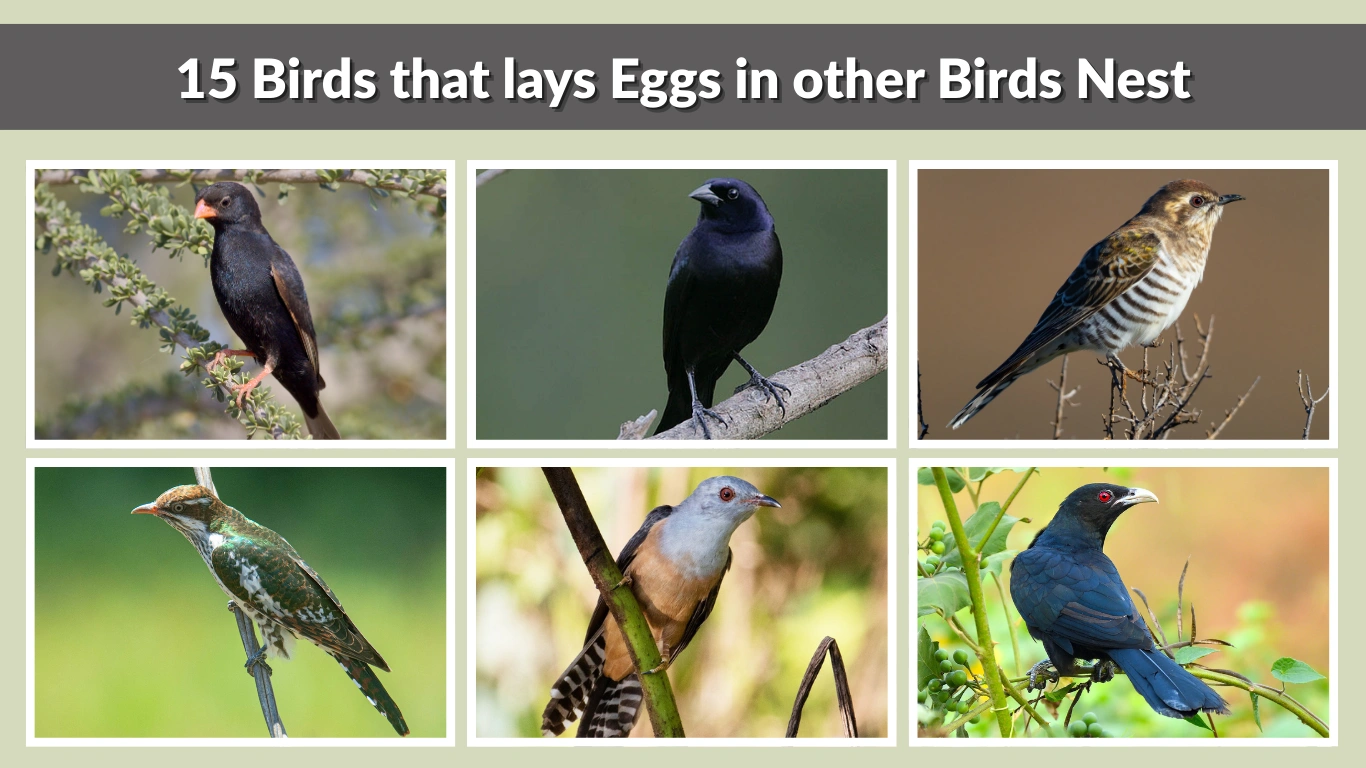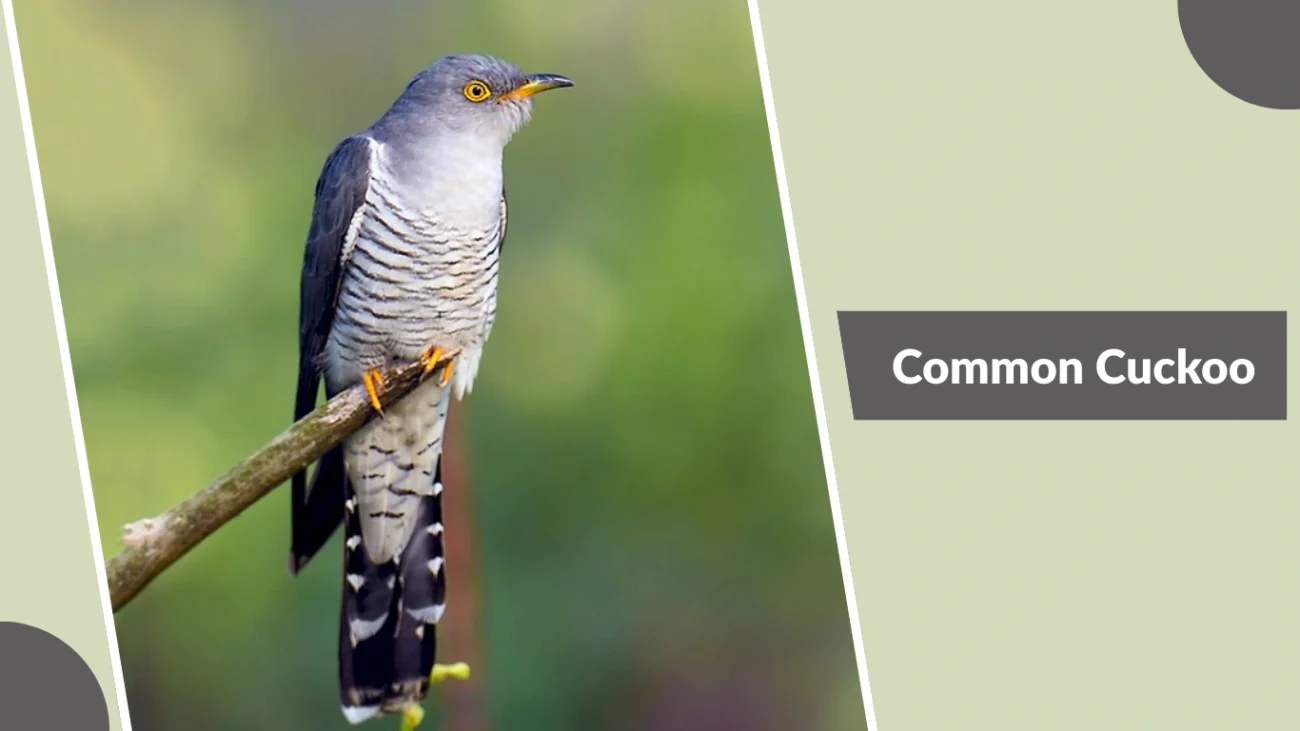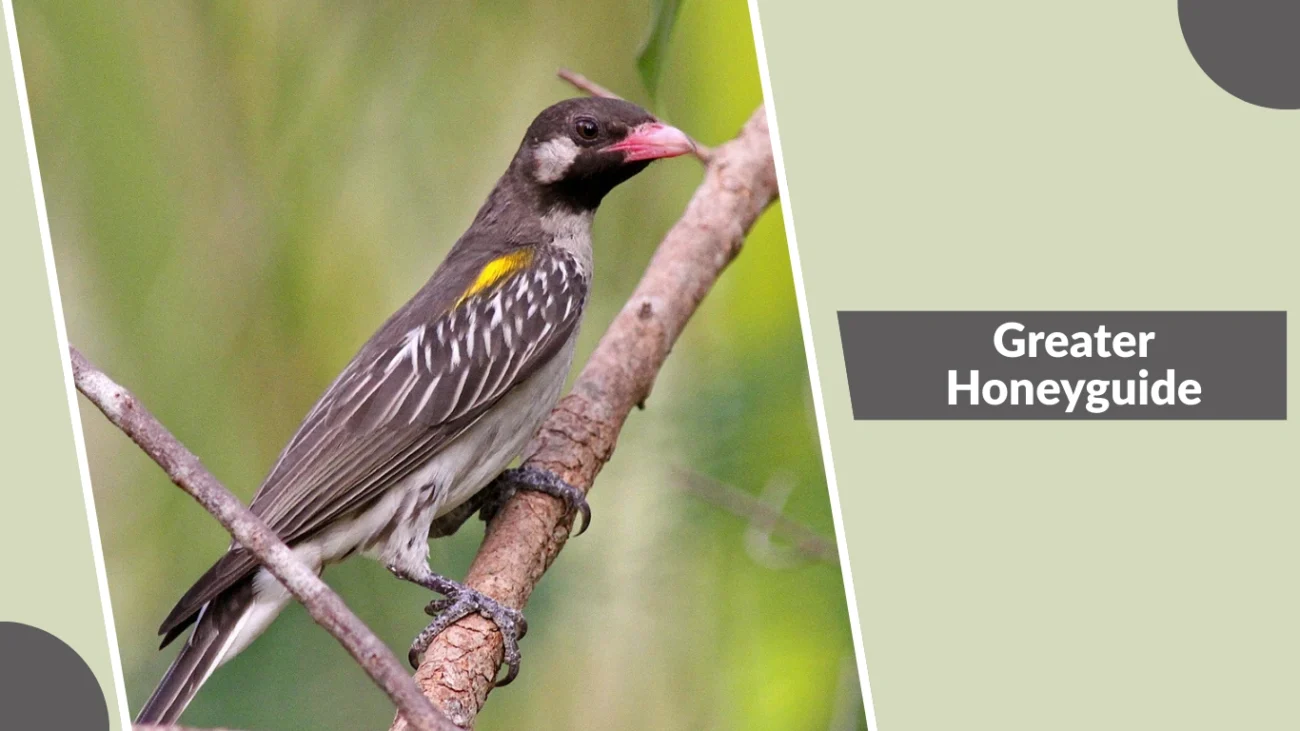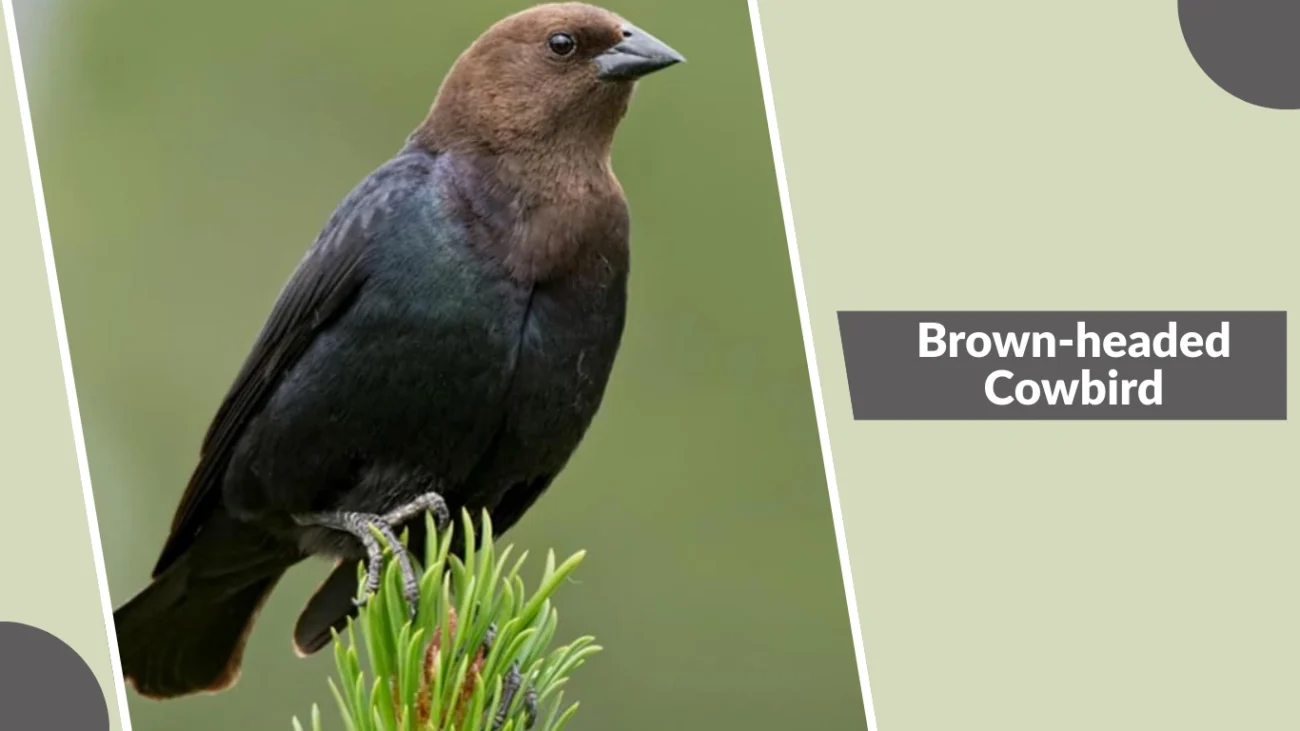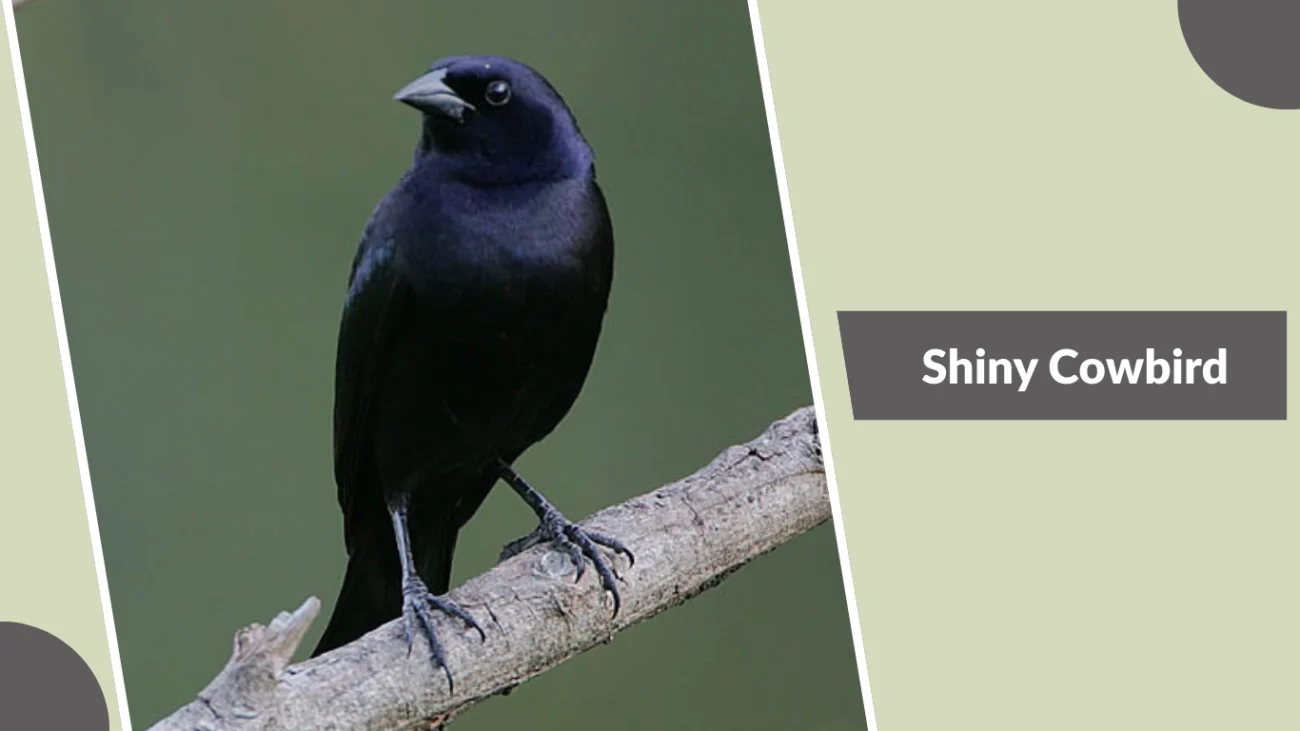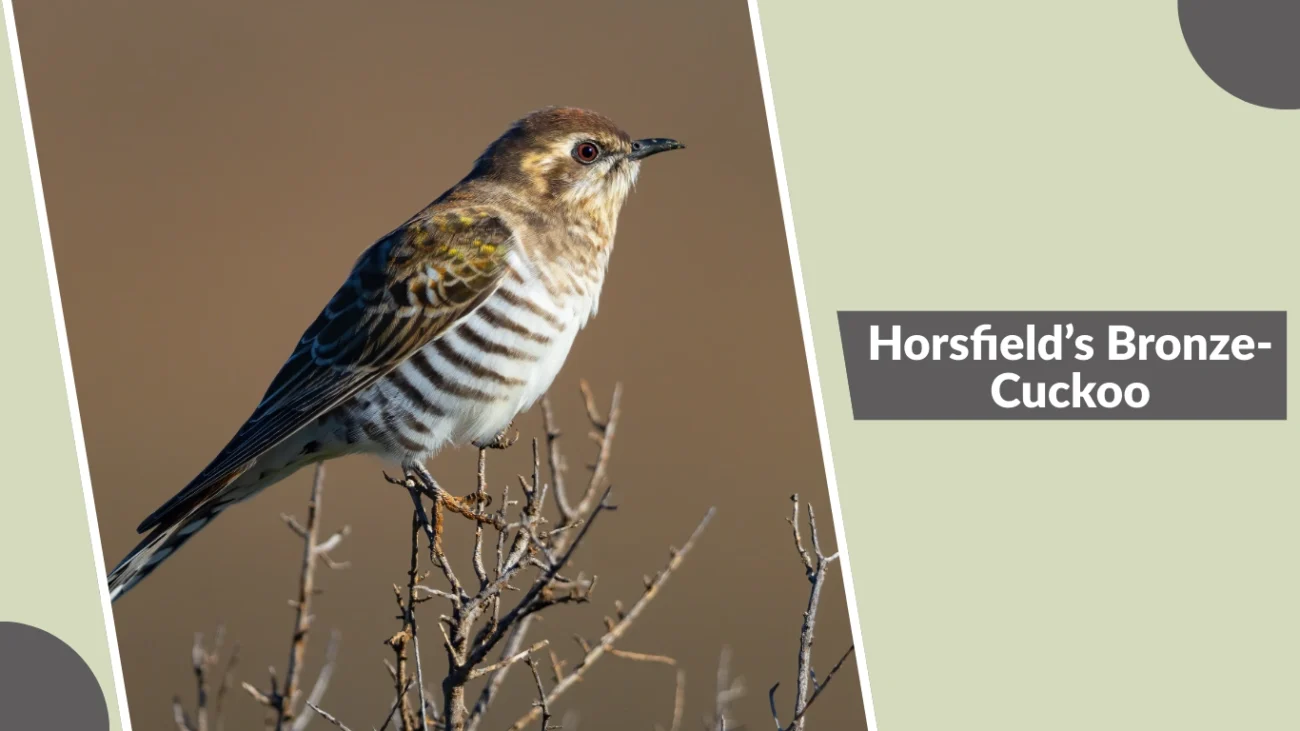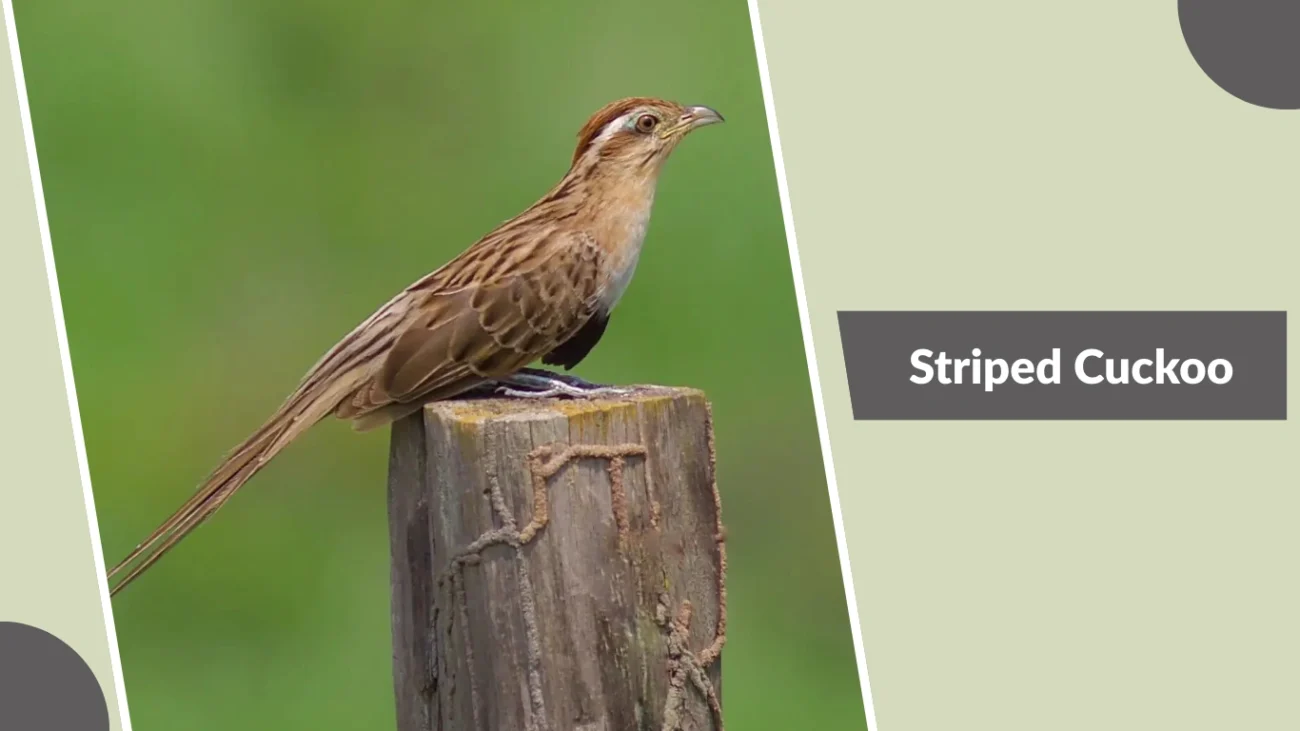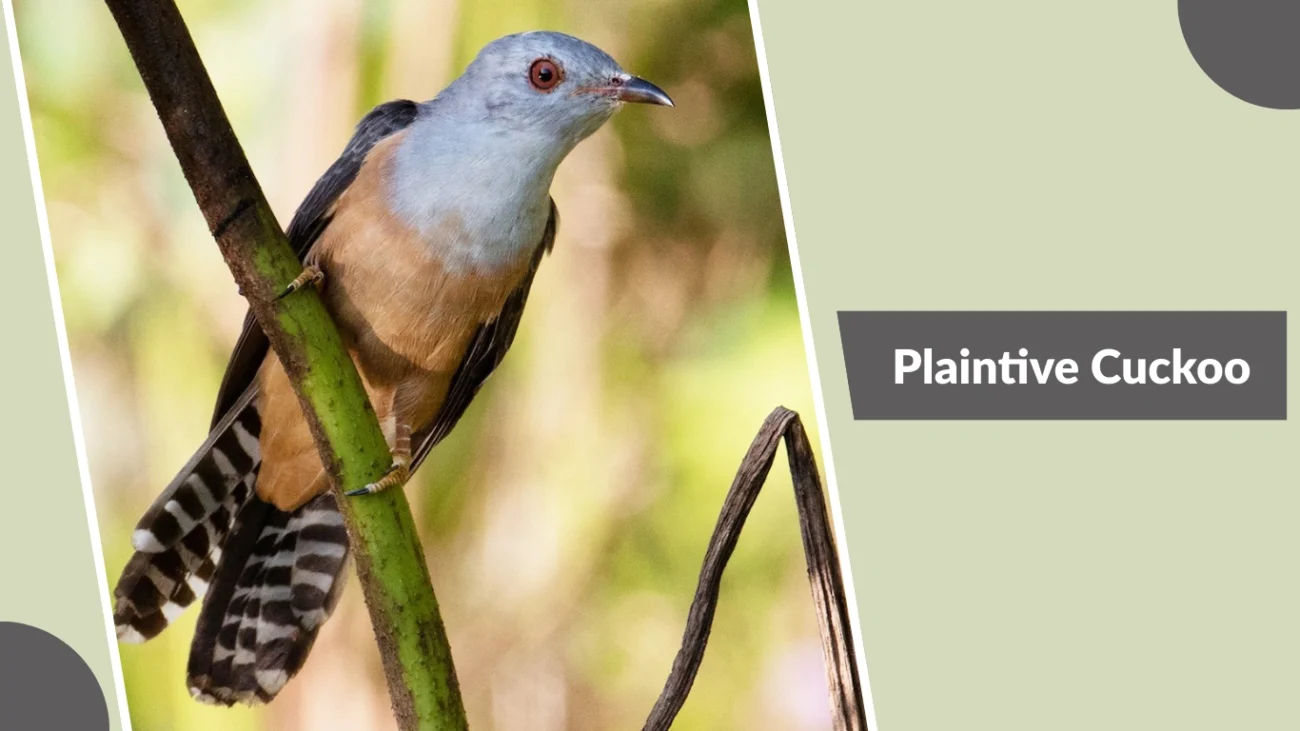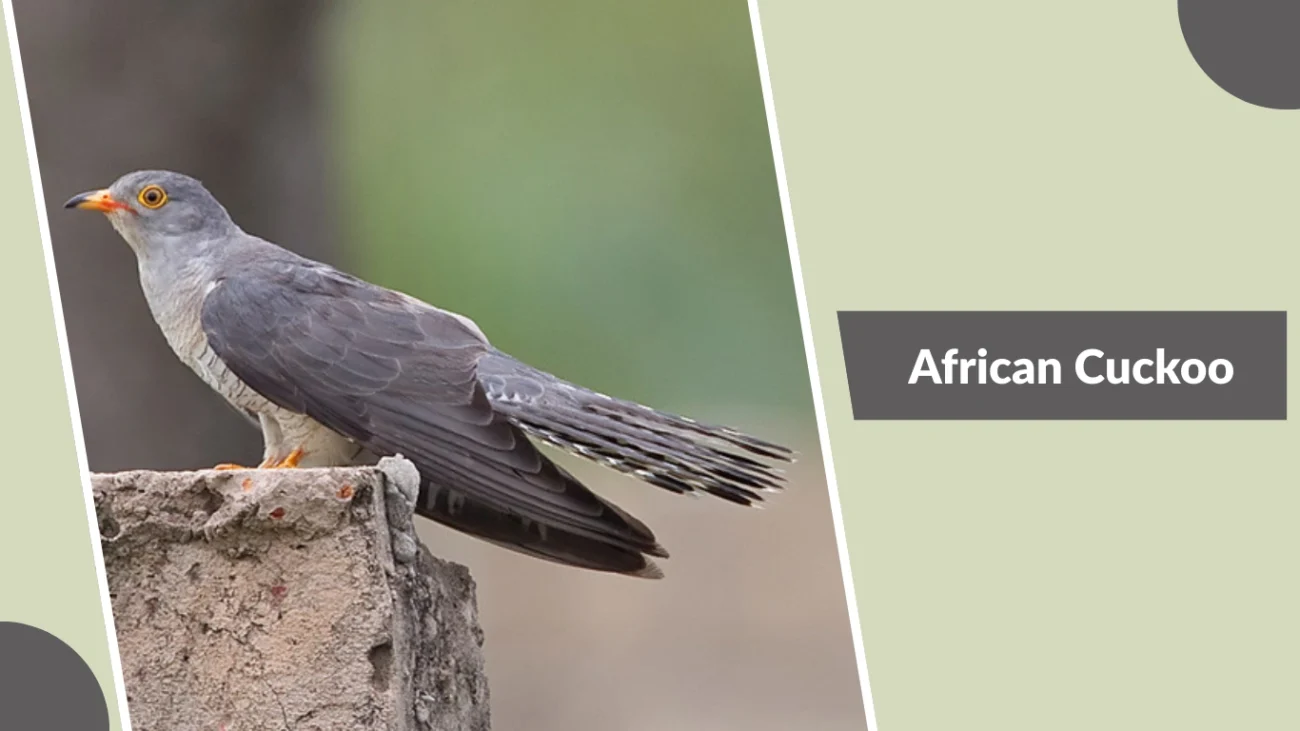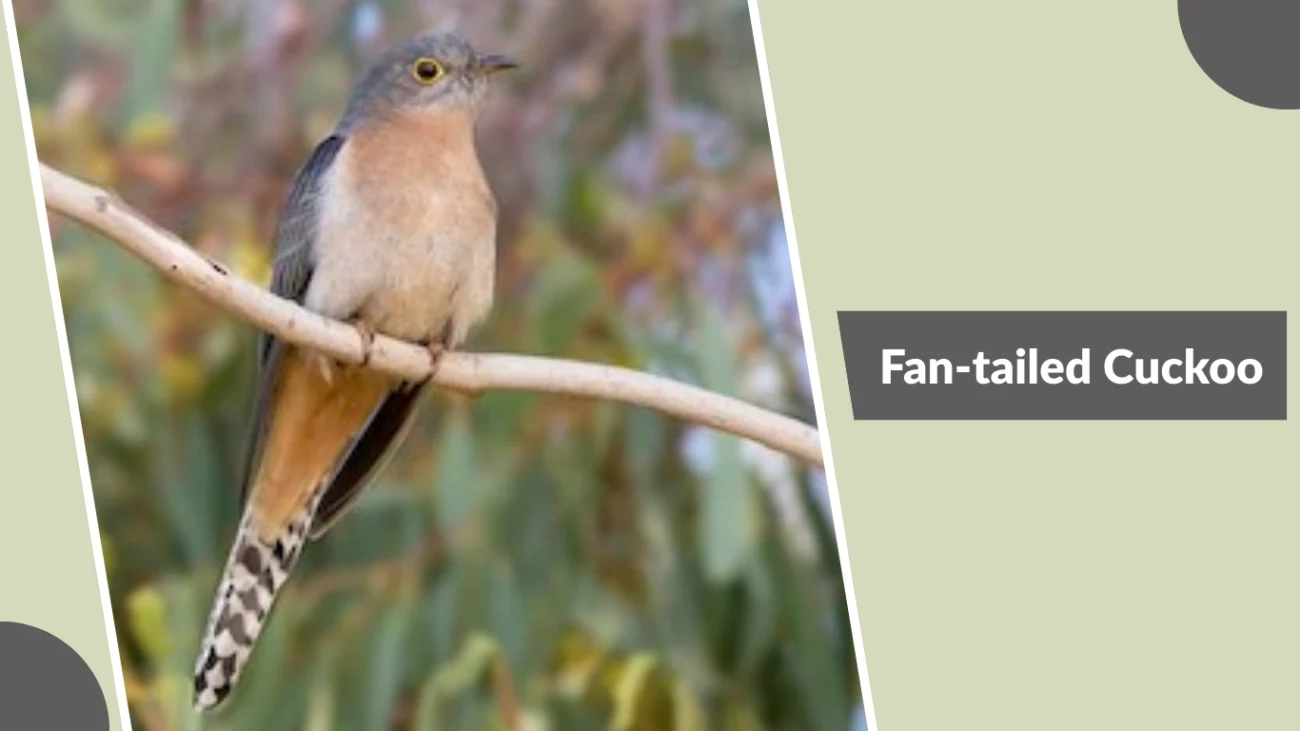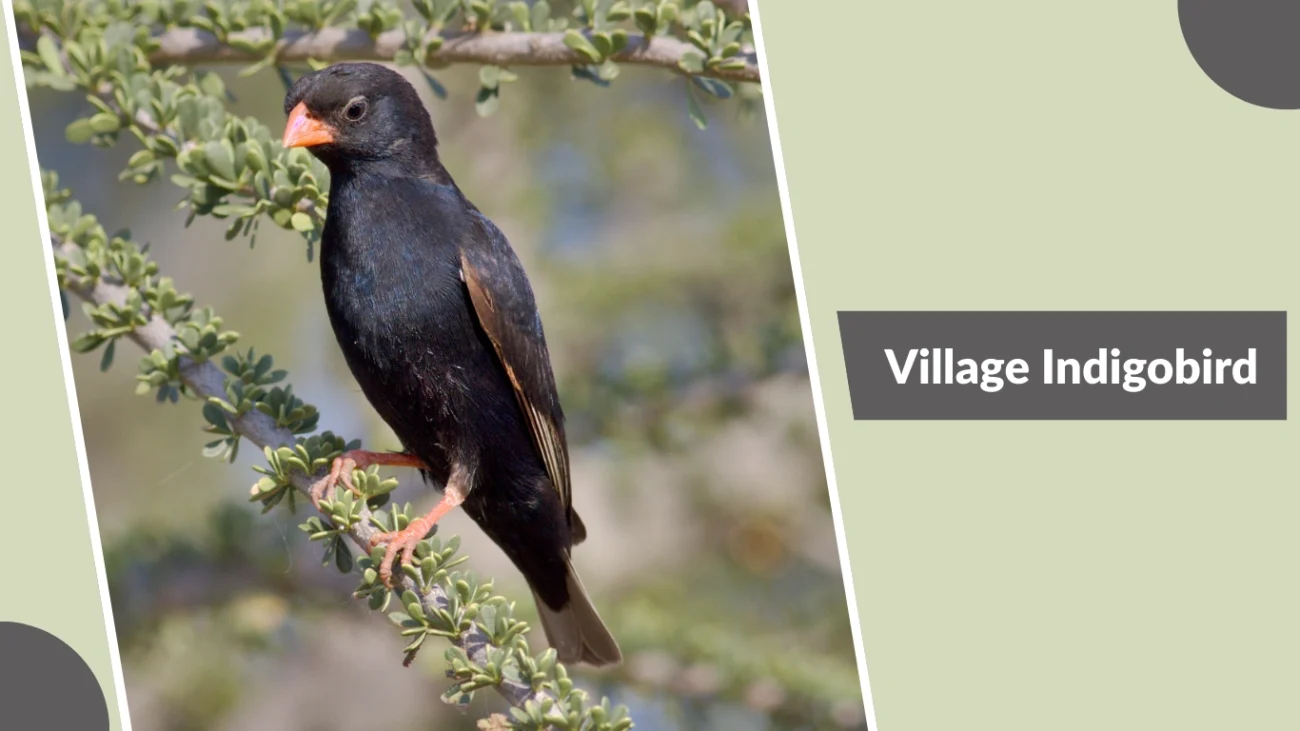Some birds have evolved a fascinating survival strategy known as brood parasitism, where they lay their eggs in the nests of other species and rely on unsuspecting foster parents to raise their chicks. From cuckoos to cowbirds and indigobirds, these clever birds showcase unique adaptations, ranging from egg mimicry to chick dominance. In this article, we’ll explore 15 remarkable bird species that practice this extraordinary breeding behavior.
1. Common Cuckoo
The Common Cuckoo (Cuculus canorus) is one of the most famous brood parasites in the bird world. Instead of raising its own young, this species lays eggs in the nests of other birds, tricking the hosts into incubating and feeding its chicks. It is widely found across Europe, Asia, and parts of Africa, making it one of the best-known migratory birds.
Identification
- Size: About 32–34 cm long, wingspan 55–65 cm
- Color: Grey upperparts, barred white and grey underparts
- Bill: Short and slightly curved
- Eyes: Yellow ring around the eye
- Legs: Short and yellowish
- Sexual dimorphism: Males are grey, females may be grey or rufous-brown morph
Habitat
The Common Cuckoo inhabits open woodlands, farmlands, grasslands, and forest edges. It prefers areas where host bird species such as warblers, pipits, and wagtails are abundant.
Behavior
This bird is highly secretive, especially during breeding season. Females stealthily lay eggs in host nests, usually removing one host egg to avoid detection. The cuckoo chick hatches earlier than host chicks and instinctively pushes out other eggs or nestlings to monopolize food.
Importance
The Common Cuckoo has long fascinated scientists, poets, and birdwatchers due to its unique parasitic breeding strategy. It plays a role in shaping the behavior and evolution of its host species, as they develop defenses to recognize and reject foreign eggs. Its distinct “cuck-oo” call is a cultural symbol in many parts of Europe, signaling the arrival of spring.
2. Greater Honeyguide
The Greater Honeyguide (Indicator indicator) is a brood-parasitic bird found in sub-Saharan Africa. It is most famous for its cooperative behavior with humans, leading people to wild beehives in exchange for access to beeswax and larvae. Despite this unique partnership, it does not raise its own chicks, instead laying eggs in the nests of other bird species.
Identification
- Size: Around 20 cm in length
- Color: Brownish upperparts with lighter, streaked underparts
- Bill: Pale and slightly hooked
- Eyes: Dark with a distinct pale eye-ring
- Sexual dimorphism: Males have a pink bill, while females usually have a darker one
- Distinct trait: Strong legs and sharp claws for clinging to vertical surfaces
Habitat
The Greater Honeyguide inhabits woodlands, savannas, and forest edges. It thrives in regions where bee colonies and suitable host bird nests are common. It often stays near human settlements, where opportunities for guiding honey are greater.
Behavior
This bird exhibits one of the most remarkable mutualisms with humans, using distinctive calls to attract attention and then leading people directly to wild beehives. After humans harvest the honey, the bird feeds on the leftover wax and bee larvae. For breeding, females lay eggs in the nests of host species like barbets, bee-eaters, and starlings. The chicks hatch with sharp hooks on their bills, which they use to kill host nestlings and secure all food for themselves.
Importance
The Greater Honeyguide is culturally significant in many African traditions, where its guiding behavior has been valued for centuries. Ecologically, it plays a role in controlling bee populations and influencing the evolution of its host birds. Its brood parasitism highlights the survival strategies some bird species evolve in order to maximize reproductive success.
3. Brown-headed Cowbird
The Brown-headed Cowbird (Molothrus ater) is a brood-parasitic bird native to North America. Instead of raising its own chicks, it lays eggs in the nests of over 200 different bird species, making it one of the most widespread and opportunistic brood parasites in the world.
Identification
- Size: About 16–22 cm long
- Male: Glossy black body with a distinct brown head
- Female: Plain brown overall with streaked underparts
- Bill: Short, thick, and conical, adapted for seed eating
- Wings: Short and rounded, allowing quick movement between feeding areas and nests
- Distinct trait: Sexual dimorphism is strong; males are striking while females are camouflaged
Habitat
Brown-headed Cowbirds are commonly found in grasslands, farmlands, forest edges, and suburban areas. They thrive in open habitats where livestock or grazing animals are present, as they historically followed bison herds to feed on insects stirred up by their movement.
Behavior
Cowbirds are highly opportunistic breeders. Females lay eggs directly into host nests, often several in one season, without providing parental care. Their eggs usually hatch faster than the host’s, giving the cowbird chick an advantage. The chicks grow quickly and often outcompete host nestlings for food, though unlike cuckoos, they do not usually push host eggs out of the nest.
Importance
The Brown-headed Cowbird has had a significant ecological impact, particularly on endangered species like the Kirtland’s Warbler, which struggles against heavy parasitism. Conservationists sometimes manage cowbird populations to protect vulnerable hosts. Despite this, the species is an important subject in studies of coevolution, as it pressures host birds to develop defenses like egg recognition and rejection.
4. Shiny Cowbird
The Shiny Cowbird (Molothrus bonariensis) is a brood-parasitic bird native to South America but has expanded its range into the Caribbean and parts of North America. Similar to its close relative, the Brown-headed Cowbird, this species lays eggs in the nests of other birds, leaving the burden of raising its chicks to unsuspecting hosts.
Identification
- Size: Around 18–22 cm in length
- Male: Glossy purple-black plumage with an iridescent sheen
- Female: Dull brown overall, often streaked on the underparts
- Bill: Short, conical, and suited for seed and insect feeding
- Eyes: Dark in females, reddish in some males
- Distinct trait: Strong sexual dimorphism; males are strikingly glossy while females are camouflaged
Habitat
The Shiny Cowbird thrives in open fields, pastures, scrublands, and urban areas. It readily adapts to disturbed habitats and is often seen around agricultural lands, where it has easy access to both food and potential host nests.
Behavior
This bird is an aggressive brood parasite, targeting a wide range of host species, from small warblers to medium-sized flycatchers. Females often destroy host eggs before laying their own. Shiny Cowbird chicks hatch quickly and grow faster, usually outcompeting or starving host nestlings. In some cases, host parents may abandon the nest altogether due to the heavy burden of feeding the larger chick.
Importance
The Shiny Cowbird is considered a conservation concern in areas where it has expanded its range, as it negatively impacts local bird populations, particularly small, endangered species. Despite its destructive reputation, it provides valuable insights into evolutionary arms races between parasites and hosts, as some host species are beginning to evolve defenses such as egg rejection.
5. Horsfield’s Bronze-Cuckoo
Horsfield’s Bronze-Cuckoo (Chrysococcyx basalis) is a small brood-parasitic bird native to Australia and nearby islands. Despite its small size, it has a remarkable survival strategy—laying its eggs in the nests of other birds, particularly fairy-wrens and thornbills, and relying on them to raise its young.
Identification
- Size: About 17–18 cm in length
- Color: Upperparts metallic bronze-green with a glossy sheen
- Underparts: White with narrow dark barring
- Eyes: Red or reddish-brown with a dark eye-stripe
- Bill: Slender, slightly down-curved
- Distinct trait: Compact size and shimmering bronze plumage distinguish it from other cuckoos
Habitat
This cuckoo inhabits woodlands, open forests, grasslands, and scrublands across most of Australia. It prefers areas where small passerines are abundant since these are its primary hosts. During migration, it can also be found in Indonesia and nearby regions.
Behavior
The Horsfield’s Bronze-Cuckoo is secretive during the breeding season, with females quietly watching host nests before laying their eggs. They typically remove one of the host’s eggs before depositing their own. The cuckoo chick hatches earlier than host young and instinctively ejects the other eggs or nestlings, ensuring it receives all parental care. Adults feed mainly on insects, especially caterpillars, which are often avoided by other birds due to their toxicity.
Importance
This species plays a significant role in the ecological balance by regulating host populations and influencing their evolutionary defenses. It is an excellent example of brood parasitism driving host adaptations, such as improved egg recognition. The Horsfield’s Bronze-Cuckoo, with its shimmering plumage and complex breeding tactics, continues to intrigue ornithologists and bird enthusiasts alike.
6. Pacific Koel
The Pacific Koel (Eudynamys orientalis) is a large cuckoo species widely distributed across South Asia, Southeast Asia, and Australia. Known for its loud and distinctive “ko-el” call, it is a brood parasite that lays its eggs in the nests of other birds, most often crows and mynas.
Identification
- Size: Around 39–46 cm in length
- Male: Glossy blue-black plumage with a long tail and striking red eyes
- Female: Brown with heavy white streaks and spots across body and wings
- Bill: Pale, slightly curved, adapted for fruit and insect feeding
- Distinct trait: Strong sexual dimorphism with males shiny black and females streaked brown
Habitat
The Pacific Koel inhabits forests, woodlands, plantations, and urban gardens. It adapts easily to human-modified landscapes and is especially common in areas with fruiting trees and abundant crow populations, which are frequent hosts.
Behavior
Males are vocal during breeding season, calling persistently to attract females. Females quietly scout host nests and deposit eggs, usually in crow or myna nests. The eggs hatch quickly, and the koel chick often outcompetes host chicks for food without ejecting them from the nest. Unlike many brood parasites, koel chicks grow alongside host young but demand most of the parental care.
Importance
The Pacific Koel has strong cultural significance across Asia, often associated with seasonal changes and featured in poetry and folklore. Ecologically, it influences host bird populations and demonstrates a different parasitic strategy compared to cuckoos that eject host chicks. Its adaptability and striking call make it one of the most recognizable brood parasites in the world.
7. Striped Cuckoo
The Striped Cuckoo (Tapera naevia) is a brood-parasitic bird found throughout Central and South America. Known for its loud, whistling call that carries far across open landscapes, this bird lays its eggs in the nests of other species, leaving the responsibility of raising its chicks to unsuspecting hosts such as flycatchers and wrens.
Identification
- Size: Around 26–28 cm in length
- Color: Brown upperparts with bold black streaks, and heavily striped underparts
- Head: Prominent crest that is raised when calling or displaying
- Bill: Slender, slightly curved, dark with a pale base
- Tail: Long with white tips, often flicked while perched
- Distinct trait: Striped plumage combined with a raised crest makes it easily recognizable
Habitat
The Striped Cuckoo inhabits grasslands, scrublands, open woodlands, and agricultural fields. It prefers semi-open habitats with scattered shrubs and trees where potential host birds build their nests. Its wide distribution extends from Mexico through most of South America, including Brazil and Argentina.
Behavior
This cuckoo is secretive when parasitizing nests. Females lay eggs in the nests of small passerines, particularly wrens and flycatchers. The eggs are well-matched in size and color to those of the host species. The chicks, once hatched, instinctively eject host eggs or nestlings, ensuring they receive all parental care. Adults feed mainly on insects, especially grasshoppers, crickets, and caterpillars, often hunting from low perches.
Importance
The Striped Cuckoo is an important species in the study of brood parasitism in the Americas. Its striking call makes it easy to detect, and its parasitic strategy significantly influences the breeding success of its host species. Ecologically, it helps regulate insect populations while serving as an example of the complex evolutionary arms race between parasites and hosts.
8. Diederik Cuckoo
The Diederik Cuckoo (Chrysococcyx caprius) is a small, brilliantly colored brood parasite found across sub-Saharan Africa. It is especially active during the breeding season of weaver birds, which are its most common hosts. Its name comes from its distinctive “dee-dee-dee-diederik” call, often heard during the African summer.
Identification
- Size: Around 18–20 cm in length
- Male: Glossy green upperparts with coppery reflections, white underparts with dark streaks, and red eyes
- Female: More brownish-green above, with heavier barring below
- Bill: Short, slightly curved, dark with a pale base
- Wings: Short and rounded with a sheen when in sunlight
- Distinct trait: Striking metallic green plumage that makes it one of the most beautiful cuckoos in Africa
Habitat
The Diederik Cuckoo inhabits savannas, open woodlands, riverine areas, and agricultural fields. It is especially abundant where weaver birds, bishops, and sparrows build their nests in colonies, providing plenty of opportunities for parasitism.
Behavior
This cuckoo is a secretive parasite, laying its eggs in the nests of small passerines such as weavers and bishops. The female carefully matches egg color to the host’s eggs to avoid detection. Once hatched, the chick instinctively ejects host eggs or nestlings, ensuring all parental care is directed toward it. Adults feed mainly on caterpillars, beetles, and other insects. Males are very vocal during the breeding season, using their loud call to attract females.
Importance
The Diederik Cuckoo plays a significant ecological role by regulating populations of insect-eating birds and influencing host evolution through egg-recognition defenses. Its dazzling plumage and melodious call also make it a well-known and admired bird in African folklore and traditional songs.
9. Plaintive Cuckoo
The Plaintive Cuckoo (Cacomantis merulinus) is a small parasitic bird widespread across South and Southeast Asia. Known for its sad, whistling call, it is a secretive species that lays its eggs in the nests of warblers and other small birds. Its simple, plaintive song often reveals its presence more than its appearance.
Identification
- Size: Around 21–23 cm in length
- Male: Grey head and chest, rufous underparts, and brownish upperparts
- Female: Two morphs – one similar to the male and another rufous (barring across body and wings)
- Bill: Slender, slightly curved, dark above and paler below
- Eyes: Reddish-brown with a dark eye-ring
- Distinct trait: Small size and distinctive whistling “plaintive” call
Habitat
The Plaintive Cuckoo inhabits scrublands, farmlands, gardens, wetlands, and forest edges. It is especially common in rice-growing regions where host species like prinias and tailorbirds build nests. Its adaptability allows it to thrive near human settlements.
Behavior
This cuckoo is highly secretive during breeding. Females watch host nests carefully and quickly lay an egg when the host is away. The eggs mimic those of the host species, reducing chances of rejection. The cuckoo chick hatches earlier and instinctively ejects host eggs or chicks, securing all parental care. Adults mainly feed on insects, especially caterpillars, grasshoppers, and beetles.
Importance
The Plaintive Cuckoo is an important species in Asian ecosystems, keeping insect populations under control. Its brood parasitism provides valuable insight into coevolution between parasites and hosts, especially in egg mimicry and host defense strategies. Its haunting call is also a familiar sound in many rural landscapes, often associated with seasonal changes.
10. African Cuckoo
The African Cuckoo (Cuculus gularis) is a medium-sized brood parasite widely distributed across sub-Saharan Africa. Closely resembling the Common Cuckoo of Europe, it lays its eggs in the nests of other birds, relying mostly on species like drongos and starlings to raise its chicks. Its loud, repetitive calls are a familiar sound in African woodlands and savannas.
Identification
- Size: About 32–34 cm in length, wingspan around 55–60 cm
- Male & Female: Grey upperparts, barred white-and-grey underparts
- Bill: Slightly curved, yellow base with a darker tip
- Eyes: Yellow with a bold eye-ring
- Legs: Yellow and fairly short
- Distinct trait: Strong resemblance to the Common Cuckoo, making it hard to distinguish without range context
Habitat
The African Cuckoo inhabits open woodlands, savannas, riverine forests, and cultivated lands. It is common in regions where drongos, one of its main host species, are abundant. Its wide range and adaptability make it a successful breeder across much of the continent.
Behavior
Like other cuckoos, the African Cuckoo practices brood parasitism. Females stealthily lay their eggs in host nests, often removing one host egg to maintain balance. The cuckoo chick hatches earlier and ejects host eggs or nestlings, monopolizing parental care. Adults feed mainly on caterpillars, beetles, grasshoppers, and other insects, many of which are avoided by other birds due to toxicity.
Importance
The African Cuckoo plays a crucial ecological role by influencing the reproductive strategies of its host species. Hosts such as drongos have developed egg-recognition defenses, which highlight the evolutionary arms race between parasite and host. Its distinctive calls and mimicry of the European cuckoo also make it a well-known bird among ornithologists and birdwatchers across Africa.
11. Fan-tailed Cuckoo
The Fan-tailed Cuckoo (Cacomantis flabelliformis) is a brood-parasitic bird native to Australia, New Zealand, and parts of Southeast Asia. Its name comes from the distinctive fan-shaped tail, which it often spreads when perched. This species lays its eggs in the nests of small insectivorous birds, leaving the burden of raising its chicks to the unsuspecting hosts.
Identification
- Size: Around 25–27 cm in length
- Color: Grey upperparts with a contrasting rufous breast and pale underparts
- Tail: Long, broad, and rounded with white-tipped feathers forming a fan-like shape
- Bill: Slender, slightly curved, dark-colored
- Eyes: Bright yellow to orange
- Distinct trait: Its fan-shaped tail and loud, descending “pee-pip, pee-pip” call
Habitat
The Fan-tailed Cuckoo inhabits forests, woodlands, heathlands, and gardens. It prefers areas with dense vegetation where small passerines such as thornbills, fairy-wrens, and scrubwrens nest. During migration, it can be found across islands of the western Pacific.
Behavior
This cuckoo is highly secretive when laying eggs, carefully observing host nests before quickly inserting its own. Its eggs often resemble those of the host to reduce detection. The chicks, once hatched, instinctively eject host eggs or nestlings, ensuring all care is directed toward them. Adults feed mostly on insects and caterpillars, particularly hairy species avoided by other birds.
Importance
The Fan-tailed Cuckoo is an important part of the ecosystem, helping regulate insect populations. It also serves as a textbook example of brood parasitism in Australasia, influencing the evolution of its hosts’ nesting strategies. Its distinctive call makes it a recognizable bird, signaling seasonal changes in many parts of its range.
12. Great Spotted Cuckoo
The Great Spotted Cuckoo (Clamator glandarius) is a striking brood-parasitic bird found across southern Europe, Africa, and parts of Asia. Unlike many cuckoos, it is larger in size and often parasitizes the nests of crows and magpies. Its loud, harsh calls and spotted plumage make it one of the more easily recognized cuckoo species.
Identification
- Size: About 35–39 cm in length, wingspan around 58–66 cm
- Color: Grey head and back, creamy underparts, with bold white spots on wings
- Tail: Long, graduated, with prominent white tips
- Bill: Slender, slightly down-curved, dark-colored
- Eyes: Dark with a pale facial patch
- Distinct trait: Strongly spotted wings and long tail distinguish it from the Common Cuckoo
Habitat
The Great Spotted Cuckoo inhabits open woodlands, scrublands, farmland, and semi-desert regions. It often lives close to human settlements where corvid hosts such as magpies and crows build large, accessible nests.
Behavior
This species is an obligate brood parasite, primarily targeting magpies and crows as hosts. Females lay eggs in multiple nests during the breeding season, sometimes with several in one host’s nest. The chicks do not usually eject host nestlings, but they are vigorous beggars and often outcompete host young for food. Adults feed mainly on insects, especially hairy caterpillars, grasshoppers, and locusts.
Importance
The Great Spotted Cuckoo plays a key ecological role in influencing the breeding strategies of magpies and other hosts. Interestingly, studies show that in some cases, magpie chicks benefit from sharing the nest with cuckoo chicks, as the latter secrete a repellent substance that deters predators. This complex relationship highlights the fascinating dynamics of brood parasitism in bird evolution.
13. Lesser Cuckoo
The Lesser Cuckoo (Cuculus poliocephalus) is a small brood-parasitic bird found across Asia, from the Indian subcontinent to Japan and Southeast Asia. It is well known in Japanese culture, where its plaintive song, called hototogisu, is a symbol of summer and has been celebrated in poetry for centuries.
Identification
- Size: Around 27–30 cm in length
- Color: Grey head and upperparts, with white underparts marked by dark barring
- Bill: Slender, slightly curved, dark with a yellowish base
- Eyes: Yellow with a thin eye-ring
- Tail: Long and rounded with white spots along the edges
- Distinct trait: Resembles the Common Cuckoo but smaller and slimmer in build
Habitat
The Lesser Cuckoo inhabits forests, woodlands, gardens, and scrublands, often choosing habitats where small passerines such as warblers and prinias are abundant. It is a migratory bird, breeding in temperate Asia and wintering in tropical regions of Africa and Southeast Asia.
Behavior
As a brood parasite, the female lays her eggs in the nests of warblers, prinias, and other small insectivorous birds. The eggs closely mimic the host’s own in color and size. Once hatched, the cuckoo chick ejects the host’s eggs or nestlings, ensuring it receives all the care and feeding. Adults feed mainly on insects, with a preference for hairy caterpillars, beetles, and grasshoppers.
Importance
The Lesser Cuckoo holds cultural significance in Japan, China, and Korea, where its call is associated with poetry, folklore, and seasonal change. Ecologically, it plays a role in shaping host bird evolution, as many species develop egg-recognition defenses against parasitism. Its widespread range and cultural connections make it one of the most iconic cuckoos in Asia.
14. Asian Koel
The Asian Koel (Eudynamys scolopaceus) is a large brood-parasitic bird widely distributed across South Asia, Southeast Asia, and parts of China. Known for its loud “ko-el” call, especially during the breeding season, it is often heard long before it is seen. Unlike some cuckoos, it usually does not eject host chicks but grows alongside them, relying mainly on crows, mynas, and other large birds to rear its young.
Identification
- Size: About 39–46 cm in length
- Male: Glossy blue-black plumage with striking red eyes and a pale bill
- Female: Brown with heavy white streaks and spots across the body and wings
- Bill: Pale greenish, slightly curved, and strong
- Eyes: Bright crimson red, a key distinguishing feature
- Distinct trait: Strong sexual dimorphism with males being sleek black and females heavily patterned
Habitat
The Asian Koel thrives in forests, woodlands, farmlands, gardens, and urban areas. It adapts easily to human settlements, often nesting close to where crows and mynas are abundant, as these serve as primary hosts. It is also strongly associated with fruiting trees, which provide a major food source.
Behavior
During the breeding season, males call persistently, especially in the early mornings and evenings. Females carefully scout host nests and deposit their eggs, usually in crow or myna nests. The koel chick hatches quickly and is fed by foster parents, often outcompeting host chicks without necessarily ejecting them. Adults feed mainly on fruits, figs, and berries, but also take insects and caterpillars.
Importance
The Asian Koel is deeply embedded in South Asian culture and literature, where its call is associated with spring, love, and monsoon rains. Ecologically, it demonstrates an alternative brood parasitism strategy that allows host chicks to survive alongside cuckoo chicks. Its adaptability and cultural prominence make it one of the most recognized parasitic birds in Asia.
15. Village Indigobird
The Village Indigobird (Vidua chalybeata) is a small brood-parasitic bird found across sub-Saharan Africa. Unlike cuckoos, it does not remove or destroy host eggs and chicks but lays its eggs in the nests of specific host species, usually red-billed firefinches. Its chicks grow up alongside the host’s young, often mimicking their calls and behaviors to ensure care.
Identification
- Size: Around 11–13 cm in length
- Male (breeding season): Glossy blue-black or greenish-black plumage with a bright sheen
- Female: Brown, streaked, and sparrow-like, providing camouflage
- Bill: Short, conical, and reddish in males; paler in females
- Tail: Males have slightly elongated central tail feathers during breeding
- Distinct trait: Strong sexual dimorphism; males strikingly glossy, females dull and cryptic
Habitat
Village Indigobirds inhabit savannas, grasslands, villages, and farmlands, especially areas near water where firefinches build their nests. They are highly adaptable and often found near human settlements where their hosts are abundant.
Behavior
Females lay eggs exclusively in the nests of red-billed firefinches and a few closely related species. The eggs closely resemble those of the host in size and color. Unlike cuckoos, indigobird chicks do not eject host young but rely on mimicry. They imitate the begging calls and mouth markings of the firefinch chicks, tricking foster parents into feeding them equally. Adult indigobirds feed mainly on grass seeds and occasionally small insects.
Importance
The Village Indigobird provides an extraordinary example of coevolution between parasites and hosts, especially in vocal learning and mimicry. Males even mimic the songs of their host species, reinforcing mate choice among females raised by the same hosts. This has made indigobirds an important subject in the study of speciation and evolutionary biology.

